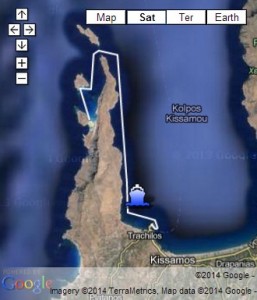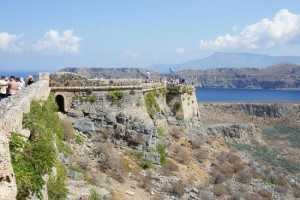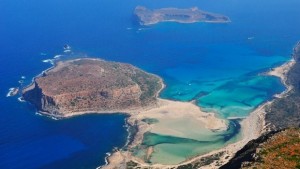The conference excursion will take place on Saturday, June 11th (approx. 9am – 6pm).
The Gramvousa/Balos region is a protected biotope. There are 400 different plants on Gramvousa, 26 of them endemic to Crete. The Anthemis glaberrima (a type of daisy), the Allium platakisi (a wild onion) and the Silene litegripetala are found only in this area and are protected species. In the shallow parts of the sea, the Mediterranean plant Posidonia oceanica thrives, providing shelter for marine life.
98 bird species have been reported in the area. 20 of them are protected and 14 of them are threatened species (like the vulture Europe Gypaetusbarbatus). The Mediterranean seal (Monachus Monachus) and the Caretta Caretta turtle find shelter in this area. Also, a flock of wild donkeys lives on the peninsula!
Program
.
Tour of Kissamos gulf
Departing from the port of Kissamos and traveling for approximately 55 minutes in the gulf, you will admire a huge cave, that is believed to have been the ancient shipyard (Tarsanas) and it is located near the Roman city Agneion and the Temple of Apollo (today Agios Sostis). During the voyage across the gulf we often come across sea turtles (Caretta Caretta), the Mediterranean seal (Monachus Monachus) and dolphins of the area.
At the end of the Gulf you will notice an impressive geological phenomenon where, as a result of the passage of time, the western part of the island is elevated, while the eastern part is sunk.
This phenomenon was created by catastrophic earthquakes that took place in 66 AC and 365 BC. These earthquakes, caused by the movement of the lithospheric plates of Africa, caused the abrupt elevation of Crete from 6m to 9m above sea level. This ancient shoreline can still be seen today as a black trace along the rocky coast.
According to scientific estimates, this geographical phenomenon, of the so called elevation, is still continuing today, but at a much slower rate.
Reaching the end of the gulf, if the atmosphere is clear and there is good visibility, as the boat passes between the island of Agria Gramvousa and cape Vouxa, one can spot the island of Antikythira in the distance. By this time and at this point, you will admire an amazing landscape, followed in the distance by the view of Valenti, Pontikonisi, the lagoon of Balos and Imeri Gramvousa, with its castle, where the boat will sail to in 15 minutes.
Visit to the island of Gramvousa
After an hour from the port of Kissamos, you arrive at the small port of Gramvousa (also called Tigani peninsula) and you can disembark, while the boat awaits your return in around 1,5 hours time.
The famous castle, was built by the Venetians in 1579 at the highest point of the island, on top of a steep rock at a height of 137m, to protect Crete from a Turkish occupation. It was one of the last unconquered bastions and it was the first area of Crete to be liberated from the Turks in 1825 (Turks were expelled from all the rest of Crete only by 1898). 3000 Cretan rebels were planning operations from Gramvousa. During this period of turmoil, the residents of the island started looting boats passing through, which gained the island its pirate reputation.
It is surrounded by a wall of 272m, where the abrupt rock does not offer any natural fortification. It has a roughly triangular shape and each side is 1km in length. The panoramic view, the imposingness and the legend of the hidden treasure of the pirates tempt you to visit it. The walk to the castle takes approximately 20 minutes.
Besides visiting the castle, you can swim at the beach next to the small church of Saint Apostles or remain on the boat relaxing and swimming around it using for your enjoyment a special water slide attached to the side of the ship.
You can also have lunch or enjoy a drink from the ship’s restaurant-bar that is open all day long.
Following the 1,5 hours visit to Gramvousa, the boat will depart for the lagoon of Balos, a journey of approximately 15 minutes.
Visit to the lagoon of Balos
Arriving at the lagoon, and because there is no port there, the ship, depending on the weather conditions, either will drop anchor in the cove of Gramvousa (Tigani) (within 200 meters from the beach and at an approximately 4m depth), and disembarkation will take place from large boats, or it will approach a point of the beach, where you will be able to disembark.
Definitely, it’s one of the most beautiful places in Greece, with its unique beautiful sandy beach and variety of shells. It’s famous for its turquoise waters, the wild natural beauty and the beautiful exotic scenery.
It is also possible, during the 2,5 hours stay to Balos, to swim to shore or remain on board, in order to relax and swim around the ship. The bar on board is open all day and you can have refreshments, coffee etc., while enjoying pleasant music.
On the ship you can return whenever you want, but you should be within that maximum ten minutes (10′) before its departure.
The cost of participation is 35 euros per person and includes transportation by bus from the hotel to the port and the boat ride.
Participants must download, complete and return the following order form before the deadline on April 08, 2016 at 09:00 GMT. The order form is available both in Word and PDF format.



